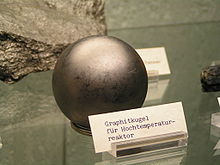
Back مفاعل ذو قاعدة حجرية Arabic Kugelhaufenreaktor German Reactor modular de lecho de bolas Spanish Kuulareaktori Finnish Réacteur à lit de boulets French Reaktor bola kerikil ID Reattore nucleare modulare pebble bed Italian 페블베드 원자로 Korean Reaktor lapisan kelikir Malay Hogetemperatuurreactor Dutch
This article needs additional citations for verification. (September 2013) |

The pebble-bed reactor (PBR) is a design for a graphite-moderated, gas-cooled nuclear reactor. It is a type of very-high-temperature reactor (VHTR), one of the six classes of nuclear reactors in the Generation IV initiative.

The basic design features spherical fuel elements called pebbles. These tennis ball-sized elements (approx. 6.7 cm or 2.6 in in diameter) are made of pyrolytic graphite (which acts as the moderator), and contain thousands of fuel particles called tristructural-isotropic (TRISO) particles. These TRISO particles consist of a fissile material (such as 235
U) surrounded by a ceramic coating of silicon carbide for structural integrity and fission product containment. Thousands of pebbles are amassed to create a reactor core. The core is cooled by a gas that does not react chemically with the fuel elements, such as helium, nitrogen or carbon dioxide. Other coolants such as FLiBe (molten fluoride, lithium, beryllium salt)[1] have been suggested.[citation needed] The pebble bed design is passively safe.[2]
Because the reactor is designed to handle high temperatures, it can cool by natural circulation and survive accident scenarios, which may raise the temperature of the reactor to 1,600 °C (2,910 °F). Such high temperatures allow higher thermal efficiencies than possible in traditional nuclear power plants (up to 50%) while the gases do not dissolve contaminants or absorb neutrons as water does, so the core has less in the way of radioactive fluids.
The concept was first suggested by Farrington Daniels in the 1940s, inspired by the innovative design of the Benghazi burner by British desert troops in WWII. Commercial development came in the 1960s via the West German AVR reactor designed by Rudolf Schulten.[3] This system was plagued with problems and the technology was abandoned.[4] The AVR design was licensed to South Africa as the PBMR and China as the HTR-10. The latter is the only operating example. Other designs are under development by MIT, University of California at Berkeley, General Atomics (U.S.), Dutch company Romawa B.V., Adams Atomic Engines, Idaho National Laboratory, X-energy and Kairos Power.
- ^ Williams, D.F. (March 24, 2006). Assessment of Candidate Molten Salt Coolants for the Advanced High Temperature Reactor (AHTR) (Report). doi:10.2172/885975.
- ^ Kadak, A.C. (2005). "A future for nuclear energy: pebble bed reactors, Int. J. Critical Infrastructures, Vol. 1, No. 4, pp.330–345" (PDF).
- ^ Association of German Engineers (VDI), the Society for Energy Technologies (publ.) (1990). AVR - Experimental High-Temperature Reactor, 21 Years of Successful Operation for A Future Energy Technology. Association of German Engineers (VDI), The Society for Energy Technologies. pp. 9–23. ISBN 3-18-401015-5.
- ^ NGNP Point Design – Results of the Initial Neutronics and Thermal-Hydraulic Assessments During FY-03 Archived 2006-06-14 at the Wayback Machine pg 20